A few weeks ago, my husband and I embarked upon a trip that enabled us to, once again, explore a state that promises something around every corner. This time our excursion took us to Titusville, where we rented a very cute and comfortable VRBO. Titusville is part of what is known as the Space Coast of Florida because it is home to the Kennedy Space Center. We chose Titusville after we discovered that accommodations were a little more reasonable than they were in Daytona--the area we wanted to explore. (For those who aren't regular readers of this blog, in the past I have covered the Space Coast and the many things to do in the area. You can read all about it
here. Merritt Island is not to be missed if you're a bird lover.)
When we arrived in Florida, it was rainy-- a situation that continued throughout our stay. The locals informed us that prior to our visit, the area had dealt with a lot of dry weather, so they rather welcomed it. Because of this, my pictures may seem a bit gloomy. If I were a beach lover, we may have felt a little ripped off, but there were plenty of things to do inside, so, for us the rain wasn't as big a problem as it could have been while we were there.
The Daytona Speedway
One of the first things many visitors to Daytona like to experience is the Daytona Speedway. Located in Daytona Beach, Florida, the Speedway is a racing venue that opened in 1959 and has been the site of numerous historic moments in motorsports, including the Daytona 500 and the NASCAR Cup Series season opener.
 |
| Daytona Speedway Photos, Courtesy Daytona Beach Area Convention and Visitors' Bureau. |
The track's banking, with 31-degree turns, challenges drivers' expertise and adds an edge-of-your-seat element to the racing experience.
The Daytona International Speedway also offers guided tours, allowing fans to explore the garages, Victory Lane and the
Motorsports Hall of Fame of America.
The Museum of Arts and Sciences
Not far from the Speedway is the
Museum of Arts and Sciences (MOAS)which includes both classical and contemporary works in the form of sculpture, painting and other mediums. It's also home to interactive and educational science exhibits which cover a large range of topics.
Within the MOAS campus is the Cici and Hyatt Brown Museum of Art celebrating Florida's landscapes and history and containing the largest private collection of Florida art in the world.
 |
| The MOAS showcases classical and contemporary works. |
An exhibit I found particularly interesting was the Coke exhibit at the Root Family Museum at the MOAS.
 |
| Vintage Coke dispensers. |
Chapman Root was a Pennsylvania boy from Wayne County who moved to Terre Haute while serving as an officer and director of North Baltimore Bottle Glass Co. In early 1901, he decided to erect his own factory and did well enough in the business to buy a 160-acre silica sand mine just outside Terre Haute for glass bottle production. Soon he was competing against 11 other companies to make the Coca-Cola bottle. Root's company won the contract in 1915 and the rest is history. The Root Family Museum showcases Root's collection of Coca-Cola dispensers and memorabilia.
 |
| More vintage coke dispensers. |
Ponce de Leon Inlet Lighthouse and Museum
 |
| The Ponce de Leon Inlet Lighthouse and Museum |
About 14 miles south of Daytona is the Ponce de Leon Inlet Lighthouse and Museum, which beckons travelers to learn about more about seafaring mysteries of the past. The lighthouse took one-and-a-quarter million bricks to build and dates back to 1883. At 175 feet, it is the tallest lighthouse in Florida and one of the tallest in the United States. Guests can ascend the 203 stairs for a spectacular view. and also roam the property, which is comprised of 11 additional buildings. Among them are the principal keeper's dwelling and outbuilding, the first and second assistant keeper's dwellings, a video theater where guests can watch a 20-minute film of the light station's history and its upkeep and more. Building #10 contains the Lens Exhibit Building, which is not to be missed. There guests can learn all about various lenses, including the famed Fresnal lenses made in France and a lens made by Chance Brothers and used at Ireland's Spit Bank Lighthouse--the last lighthouse to be seen by passengers aboard the Titanic.
 |
| Keepers of the lighthouse. |
 |
| Taken inside the Lens Exhibit building. |
Towards the rear of the property is an area shown on the map as "Coastal Hammock." I neglected to explore that territory, so when I arrived home and saw details in the brochure, I wished that I had paid more attention to the map they had given us. The "Coastal Hammock" was an area of importance to the lighthouse keepers in that it provided a source of items for their "cookpots," which included squirrel, opossum, snakes, birds, turtles, snakes and raccoons. Guests who visit are cautioned to bring bug spray since mosquitoes can be heavy during certain periods of the year.
The Marine Science Center
Located a short drive from the Ponce Inlet Lighthouse is The Marine Science Center, a facility whose mission is to educate the public on marine education, rehabilitation and conservation. When we visited, I had the opportunity to pet a stingray and now if people ask me what that feels like, I can tell them slimy velvet.
 |
| Guests can pet the Stingrays, which feel like slimy velvet. |
The small facility doesn't take long to tour and visitors can view aquariums housing marine creatures and also enjoy the nature trails surrounding the facility. A priority for the center is sea turtle rehabilitation and guests can view the turtles and learn about the rehabilitation process.
 |
| Frank toddles around in the recovery tank. |
Vero Beach
Next up was a trip to Vero Beach, which was over two hours to the south, but an area definitely worth seeing. It boasts beautiful unspoiled beaches along the Atlantic and features boutique shops for blocks. We're already thinking about staying in the area on a future visit.
Our first stop in Vero Beach was
McKee Botanical Garden, a lush, tropical oasis that spans 18 acres of lovely, landscaped grounds containing a collection of tropical plants, palms and flowering trees.
Water features include ponds, streams and water lily displays. The destination dates back to 1929 and was one of Florida's earliest attractions.
 |
| An owl keeps a watchful eye over the gardens. |
 |
| A unique bench to rest and observe. |
Those with kids in tow might be interested to learn that McKee has a dedicated Children's Garden to engage the little ones in learning about and interacting with flora and fauna.
 |
| This cool, steampunk-looking telescope/planter enables visitors to see plants close up. |
 |
| A giant mushroom. |
The walk through McKee is beautiful and serene and on the November day when we visited, few people were around due to a threatening storm. Thankfully, we were able to take in the entire experience before the downpour.
The Vero Beach Museum of Art
 |
| The entrance to the Vero Beach Museum of Art. |
Next, we visited the Vero Beach Museum of Art where the work of M.C. Escher was front and center. The temporary exhibit runs through the end of December and explores the graphic artist's mathematically inspired work. Escher lived from 1989 to 1972 and one of his most famous pieces titled "Drawing Hands" was among the collection. Note for left-handers--Escher was one.
 |
| One of Escher's more famous works called "Drawing Hands." |
Another one that stood out to me was "Three Spheres," a study of reflective surfaces.
 |
In "Three Spheres" Escher studied reflective surfaces.
|
In addition to the Escher exhibit, the Vero Beach Museum of Art features a collection of American, Asian and contemporary pieces. It also offers programs for children, adults and families which include art classes, workshops, lectures and gallery talks. While we were there, a classroom of children were being led by a guide who was educating them on the background of the Dutch artist and his many works of art.
The Treasure Museum
Our last stop was the McClarty Treasure Museum north of Vero Beach, which is run by the Florida State Park system. It displays artifacts from the 1715 Spanish Plate Fleet, offering an educational experience for those interested in exploration and underwater archaeology.
The 1715 Fleet, which was battered by a hurricane, was comprised of about a dozen merchant ships carrying cargoes of gold and silver from the American colonies to Spain. About 1500 men, women and children who survived the disaster made their camp at the site where the Treasure Museum stands now.
A docent stands at the ready to greet visitors and explain the story of the survivors and what has been discovered at the site over the years.
 |
| A recreation of an encampment erected by the survivors. |
 |
| Artifacts found after an archeological dig. |
Governor General Corcoles ended up sending a relief party to assist the stranded individuals and also recover the cargo.
At the end of the tour, visitors can climb to a lookout point outside to get a view of what the victims may have beheld. On the day we visited, the weather was threatening, so it wasn't hard to imagine how it may have appeared all those years ago.
 |
| Visitors can climb a hill to a lookout point at the end of the tour. |
Well, that's about it for this blog entry. What may be surprising is that we did all this in a period of four days. Although it included quite a bit of driving, it did expose us to new and different destinations in a state that is just brimming with things to experience.


































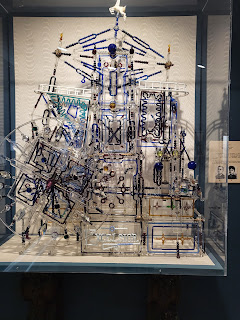

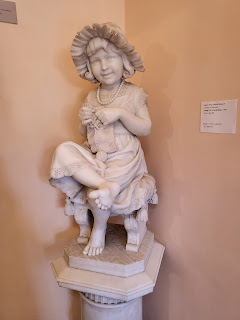








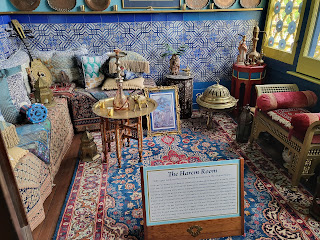



.jpg)





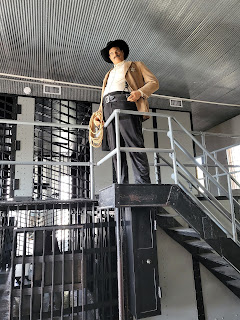


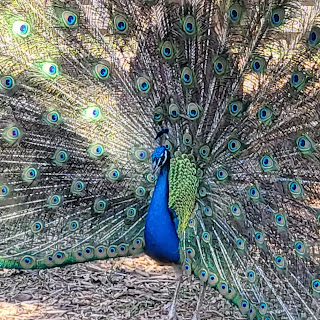


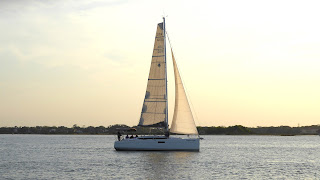



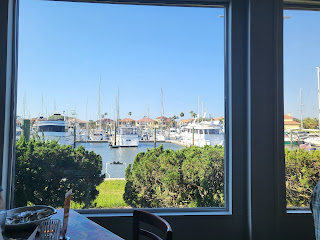
.jpeg)
.jpg)